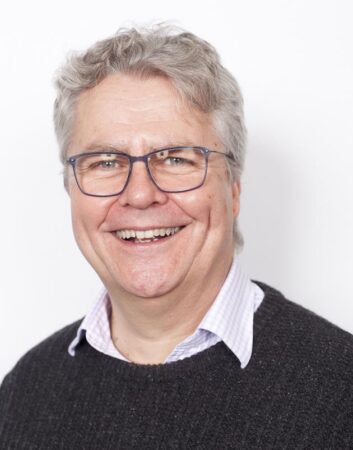
‘How our chromosomes are replicated’ is the title of the 2019 Max Perutz Lecture to be given by John Diffley on Wednesday 26th February at 11.00am, in the LMB’s Max Perutz Lecture Theatre. The event is open to anyone in the local area who is interested in attending.
John is currently Associate Research Director at the Francis Crick Institute, London, and Head of the Chromosome Replication Laboratory. His group is studying how cells copy their DNA (replication) and finding out how mistakes in this process lead to cancer. They have discovered many of the mechanisms that regulate this process, ensuring that DNA is accurately copied just once every time a cell divides. To do this, they use a range of methods to study the molecular ‘machines’ that copy DNA in yeast and human cells. Recently they have developed a way of using these machines to copy DNA in a test tube, giving an unprecedented view of this fascinating and essential process.
John was born and raised in New York City. He obtained his B.A., M.S. and Ph.D. from New York University. He then worked as a postdoctoral fellow in Bruce Stillman’s laboratory at Cold Spring Harbor from 1984–1990, where he began working on yeast DNA replication. He moved to the Clare Hall Laboratories, Imperial Cancer Research Fund in 1990 as a Junior Group Leader. He was promoted to Senior Group Leader in 1995. He became Director of the Clare Hall Laboratories and Deputy Director of the London Research Institute (Cancer Research UK) in 2006. With the founding of the Francis Crick Institute in 2015, he became Associate Research Director. In 1998 he was elected a member of the European Molecular Biology Organisation (EMBO) and in 2005 he was elected a Fellow of the Royal Society. He won the Paul Marks Prize for Cancer Research in 2003 and the Louis Jeantet Prize for Medicine in 2016. He currently serves on several scientific advisory boards and national and international grant panels.
Lecture abstract:
The eukaryotic cell cycle coordinates the accurate duplication and segregation of the genome during proliferation. The large genomes of eukaryotic cells are replicated from multiple replication origins during S phase. These origins are not activated synchronously at the beginning of S phase, but instead fire throughout S phase according to a pre-determined, cell type specific program. In addition to duplication of genomic DNA, all of the protein components of chromosomes must be duplicated and placed in the correct locations during S phase so gene expression patterns can be maintained. Replication must also be coordinated with many nuclear processes including sister chromatid cohesion, replication checkpoint activation, postreplication repair and chromatin assembly.
Ensuring that each origin is efficiently activated once and only once during each S phase is crucial for maintaining the integrity of the genome. This is achieved by a two-step mechanism. The first step, known as licensing, involves the loading of the Mcm2-7 proteins into pre-replicative complexes (pre-RCs) at origins. In the second step, the MCM helicase is activated by a large set of ‘firing factors’. These two steps are differentially regulated by cyclin dependent kinase (CDK): licensing is inhibited by CDK, whilst firing requires CDK. As a consequence, licensing can only happen during G1 phase, when CDK activity is low, and origin firing cannot occur during G1 phase. Misregulation of this system can generate chromosome rearrangements which may contribute to genome instability in cancer.
We have described the reconstitution of yeast DNA replication with purified proteins. I will present recent results using this system to study the mechanism of DNA replication and the processes associated with it, ensuring accurate chromosome duplication.
Background information:
The Max Perutz Lecture is named in honour of LMB Nobel Laureate Max Perutz. It is one of a series of named lectures organised by the LMB to be given by eminent scientists from around the world. Max Perutz arrived at the Cavendish Laboratory in Cambridge in 1936, to work in the field of X-ray crystallography. This move would lead to him becoming a pioneer in the new field of molecular biology, co-founding a world-class research laboratory and developing a technique to unlock the structures of proteins. Max played a key role in the history of the LMB. He was Director of the ‘MRC Unit for Research on the Molecular Structure of Biological Systems’ when it was established in 1947; and when the unit became the MRC Laboratory of Molecular Biology (LMB) in 1962, he became its first Chairman. Max Perutz officially retired as Chairman of the LMB in 1979, having overseen the development of the MRC unit into a first class research laboratory. He died in Cambridge on 6 February 2002, aged 87.